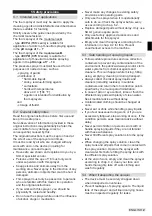
ENGLISH
3
5.5 Work clothing /personal protection
equipment (PPE)
Suitable and approved protective clothing
that protects all body parts from contact with
the spray solution must be worn.
x
Wear firm shoes with good gripping soles.
x
Wear protective gloves with a slip-proof
palm.
x
Use facial protection (e.g. protective
goggles).
x
Wear a respirator when using dangerous
spraying agents.
5.6 Before and during work
x
Before starting work, always check the entire
device for operational safety according to
chap. 6.2.
x
The sprayer must only be operated by one
person. There must be no other person within a
radius of 15m [approx. 16 yards].
5.7 Maintenance, repair and storage
Only perform maintenance and repair work yourself
that is described in these original instructions. All
other work must be carried out by an authorised
specialist workshop.
x
Do not service, repair or store the sprayer near
open fire.
x
Before doing any maintenance work or repairs
and before opening the spraying agent tank,
depressurise the device by pushing on the
pressure relief valve (d) (Fig. 2).
The device always must be vertical when the
pressure relief valve is actuated.
Attention: Keep the device away from your face!
x
The pressure hose, hand valve, spray wand and
nozzle assembly must only be unscrewed when
the sprayer is depressurised.
6 Work preparation
Fig. 1:
a
Spraying agent tank
b
Flange
housing
c
Pump
handle
d
Pressure relief valve
e
Shut-off
valve
f
Spray
tube
g
Foam adjustment unit
h
Nozzle
attachment
6.1 Assembly
Fig. 2:
x
Firmly screw the foam adjustment unit (
g
) with
the nozzle attachment (
h
) hand-tight onto the
spray tube. Do not use any tools!
x
Fasten the threaded collar (
k
) on straight and
firmly screw the spray tube (
f
) with O-ring
(16x3 mm) hand-tight onto the shut-off valve (e).
Do not use any tools!
Fig. 1:
When your work is completed, the spray tube
should be fitted into the holding clamp at the pump
handle (
c
).
Please put the foam adjustment unit (
g
) completely
up.
6.2 Checking for operationally safe condition
Subject the foam sprayer to a visual inspection
before every use. There must be no cracks evident
at the tank (
a
), the pump handle (
c
), the foam
adjustment unit (
g
) and the nozzle attachment (
h
).
The following inspections must be performed at
first commissioning and at recommissioning after
extended standstill. During use of the foam
sprayer, proper function generally must be verified
in operation.
x
Tightness of all sprayer parts at maximum
admissible pressure with the hand valve opened
and closed
x
Function of all working parts (hand valve, pump,
pressure relief valve)
For this, build up pressure across the pump. The
pressure must escape with a clearly audible sound
when you actuate the pressure relief valve (Fig. 2).
The device always must be vertical when the
pressure relief valve is actuated. Attention: Keep it
away from your face!
Check the function of the shut-off valve during
application. When releasing the shut-off valve,
spraying must stop.
In case of irregularities, damage, leaks or limited
function, do not use the sprayer but have it
checked in a specialist workshop without delay.
7 Preparing the spray liquid and filling the
spray tank
Prepare the spray liquid according to the
instructions of the chemical manufacturer.
Always prepare the spray liquid outdoors, never in
living quarters, stables or storage rooms for food
and animal feed.
Before opening the spraying agent tank,
depressurise the device by pulling on the pressure
relief valve (Fig. 2). Before pulling on the pressure



























